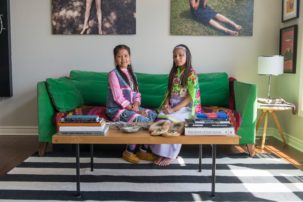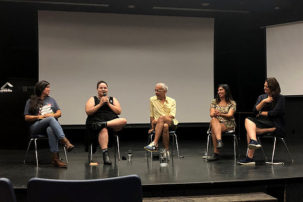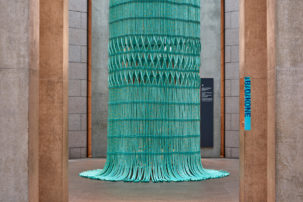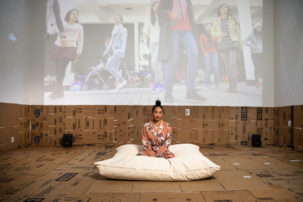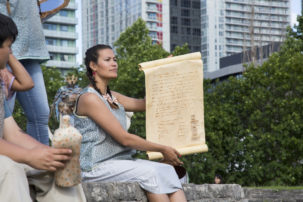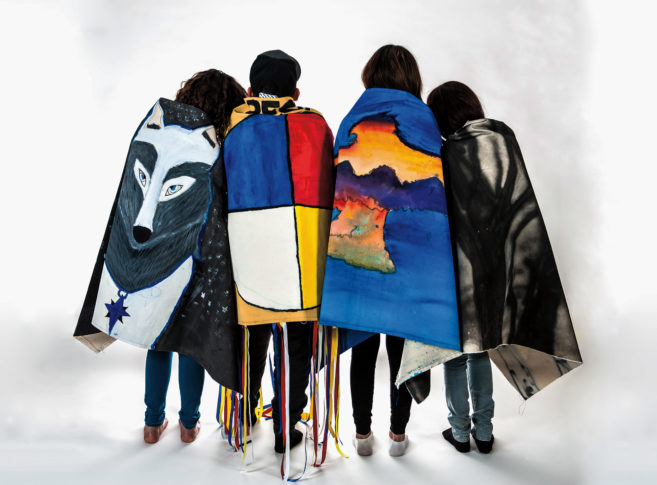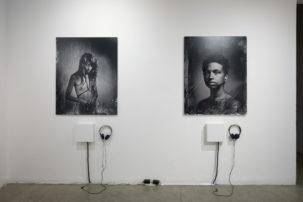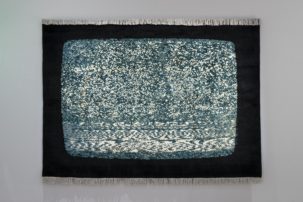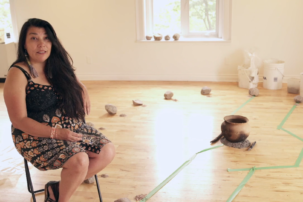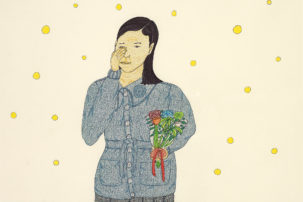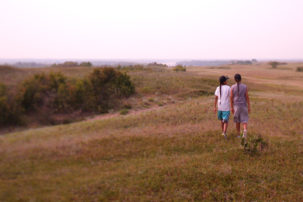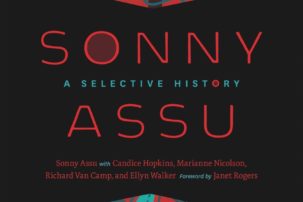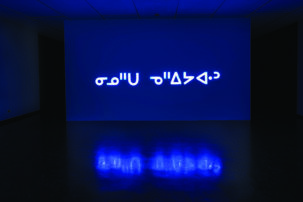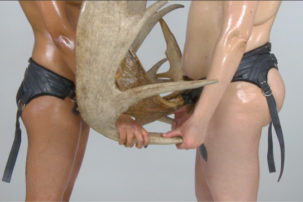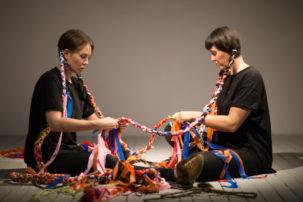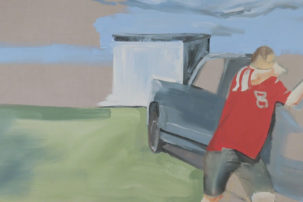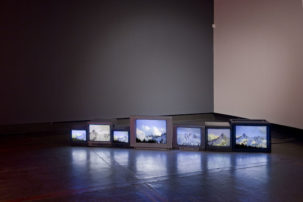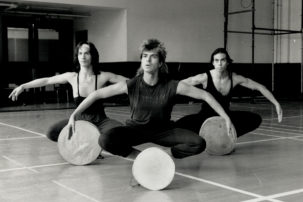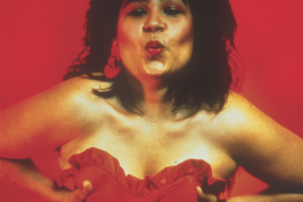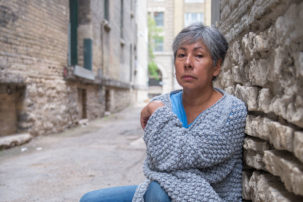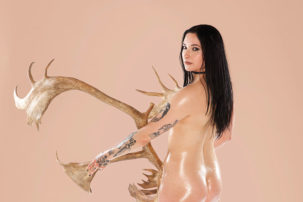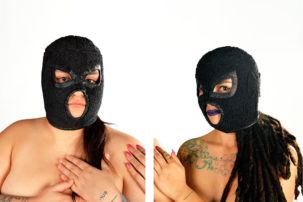Soft Power
San Francisco Museum of Modern Art, October 26, 2019, to February 17, 2020
Art for Strange Times
While we’re living and working in separation, art offers connection, distraction and ways to find ourselves anew. Here, five Canadian Art editors share what we’ve been looking at over the past week
Wet’suwet’en Strong
Who are the Indigenous artists on the front lines of the land defence and protest rallies for Wet’suwet’en?
A Year in Relations
To wrap up the year, Canadian Art editors look back at 2019 and consider the exhibitions and experiences that stayed with us most
Indigenous Art Is So Camp
An international Indigenous art exhibition at the National Gallery of Canada reveals a feminist, camp aesthetic
The Future Is Femme
Sobey Art Award winner Stephanie Comilang discusses representation, family and why she feminizes drones in her videos
Meky Ottawa
La Guilde, Montreal, July 25 to September 29, 2019
A New Kind of Land Acknowledgement
Artist and Toronto Biennial advisor Ange Loft, senior curator Candice Hopkins and deputy director and director of programs Ilana Shamoon talk to Lindsay Nixon about what it means to use a land acknowledgement as a guiding principle for curatorial and artistic work
Women and Water Illuminate the World
The ReMatriate Collective’s exhibition at the Bill Reid Gallery represents Northwest art differently, highlighting women carvers, feminine water ceremonies and even a lesbian creation story
The Current Comes from There
In September 2020, Ociciwan Contemporary Art Centre opened its doors in Edmonton. Find out more about how the Indigenous art centre came to be in this summer 2019 feature.
A Different Kind of Futurism
Kali Spitzer reclaims historical photography in her recent exhibition “An Exploration of Resilience and Resistance”—and reveals a queer Indigenous future
You Want Our Art but Not Our People
Dressed in regalia to support their kin at the 2019 Whitney Biennial opening, a group of NDNs experience art-world militarization first-hand
In the Studio with KC Adams
“I've always jumped from medium to medium,” says this influential Indigenous artist. She adds: “There was a lot of things that we had to do for survival. I’m just merely following the footsteps of the ancestors”
Stories Not Told
Let’s honour Annie Pootoogook’s profound work, legacy and life. But let’s also talk about Inuit art as an industry, and who is left out of institutional reconciliation
nîpawistamâsowin: We Will Stand Up
On the opening night of the 2019 Hot Docs film festival, Tasha Hubbard premiered a new documentary on the death (and life) of Colten Boushie
Sonny Assu: A Selective History
A new book shows why Assu doesn’t blink an eye at “defacing” some of Canada’s most treasured artworks
Our Languages Live Within Us
Words affect the way we make, do and think. For Indigenous artists, various types of communication don’t always translate—to English, or to written or spoken language
A Year in NDN Art
Our generation of queer and trans fem creators are sick of working within industry structures of scarcity and cruelty—we just want to make work for the people we love
Who Benefits from the Indigenous Art Biennial?
A look at the 4th BACA biennial reveals the difference between working in Indigenous ways, and working in Indigenous art—and Niki Little and Becca Taylor’s resolve to curate to and for their sisters
A Conversation with Brenda Draney
Viewing a Brenda Draney painting is like witnessing a dream. Here, the artist speaks about the role of small-town memory and mystery in her work
What Do We Mean by Queer Indigenous Ethics?
Billy-Ray Belcourt and Lindsay Nixon discuss the ways in which queer and trans Indigenous folks enact another kind of art and theory.
Maybe There’ll Be a Better Tomorrow: A Conversation with Shelley Niro
As her career retrospective debuts in Toronto, Shelley Niro sits down to talk about Indigenous femininities, picking berries, and the sometimes-tricky ratio between darkroom work and family time
Art in 2017: A View from Turtle Island
Strong exhibitions in Winnipeg, Kitchener-Waterloo and Toronto highlight an Indigenous critic’s year-end bests.
We Lost an Entire Generation
Indigenous peoples remain ghettoized within, and largely absent from, what is often considered to be AIDS art.
Nation to Nation
Remembering “Native Love,” an exhibition that confronted the warrior rhetoric surrounding the Oka Crisis through concepts of love, sensuality and care.
Rebecca Belmore Wants Us to Listen to the Land
Twenty-six years ago, artist Rebecca Belmore prompted Canadians to speak to the land. Now, her newest artwork urges us to listen to it.
This Work Is Not for You
“This issue is a love letter to all my fierce and fabulous relations—my NDN baby girls, women or otherwise—who ground their work in kinship teachings.”
Making Space in Indigenous Art for Bull Dykes and Gender Weirdos
It’s about time for the Indigenous art canon to create a space for gender-variant and sexually diverse voices. They’ve been mostly excluded for decades.

